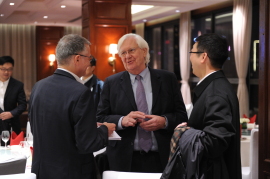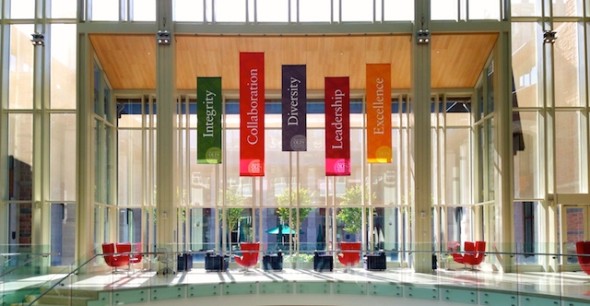Olin Business School’s joint Executive MBA (EMBA) program with Fudan University in Shanghai is #7 in the 2014 Financial Times (FT) survey and remains among the most highly ranked programs globally. Among EMBA programs based in Mainland China, the Olin-Fudan program ranks #2.
“As one of the first western schools to partner with a Chinese university and introduce executive education to the Asian market, Olin is extremely proud of more than 800 highly successful alumni from our program with Fudan University,” said Mahendra R. Gupta, dean of Olin Business School. “Our excellent faculty are dedicated to preparing global leaders who can manage the challenges of doing business in the 21st century.”

Prof. Jim Little chats with EMBA students in Shanghai.
Based on surveys of alumni who graduated in 2011, 2012, and 2013, and information provided by the business schools, The FT rankings are based on multiple criteria from students’ salary increases to the volume of research published by faculty.
Candidates accepted to the Olin-Fudan program are among the most highly experienced and accomplished executives. The majority are at a directorship level or higher when they enter the program. When compared to all the schools in the FT survey, Olin-Fudan incoming students rank at #11 on the global scale of work experience.
The Shanghai-based program is taught in English by tenured faculty of Washington and Fudan universities. Students attend intensive monthly sessions for 22 months with a rigorous and demanding curriculum. Graduates report salary increases of more than 50% according to the new FT survey. Olin-Fudan alumni are not only prepared to take their careers to the next level upon completion of the EMBA program but they continue to benefit from the global alumni networks of two highly respected universities.
In the category of research, the Olin-Fudan program ranked #11 globally, reflecting the important role that faculty research plays in Olin’s mission to create knowledge and use research as a teaching tool. This category is calculated according to the number of articles published by a school’s current full-time faculty members in 45 academic and practitioner journals between January 2011 and August 2014. The rank combines the absolute number of publications with the number weighted relative to the faculty’s size.
The Olin-Fudan premier EMBA program attracts a diverse cohort of students each year from multi-national companies based in China and throughout Asia. Nearly half (49%), of the international EMBA candidates in the Shanghai program are women, the highest percentage among the top-tier schools in the FT survey.
Washington University launched its Executive MBA program 30 years ago in St. Louis and it continues to grow in recognition and reach. The Shanghai-based program was established in 2002 and more recently, the program has expanded to Kansas City (2009), and Denver (2013). In 2015, Olin and the Indian Institute of Technology-Bombay’s Shailesh J. Mehta School of Management will launch the first joint EMBA program of its kind in Mumbai, India.
The Financial Times’ 14th annual ranking of executive MBA degrees included 132 programs from 32 countries, including 17 offered jointly by more than one school.
To view the rankings and methodology, please click here.





 Only one out of the top 50 ranked schools could boast better placement numbers than Olin in 2014. We are proud to say that 96.9% of Olin MBA grads were employed 90 days post-graduation. Job placement success accounts for more than a third of the U.S. News ranking score.
Only one out of the top 50 ranked schools could boast better placement numbers than Olin in 2014. We are proud to say that 96.9% of Olin MBA grads were employed 90 days post-graduation. Job placement success accounts for more than a third of the U.S. News ranking score.





